Audit Formats and Requirements
Audit Formats
If you ran the audit with more than one format, there will be an ‘Audit Format’ button below the ‘Categories’ charts. You can click the ‘Audit Format’ button to have the option to download the Audit PDF.

Web Audit Format
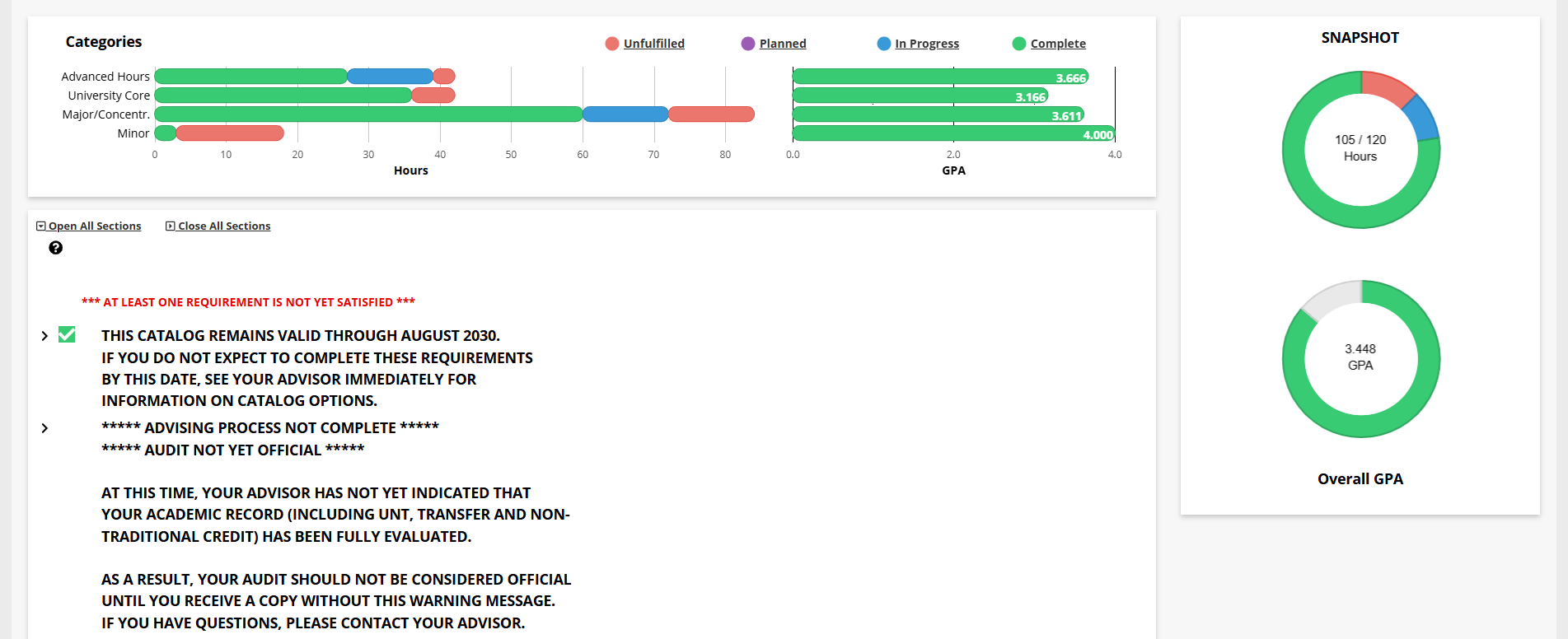
Each requirement for the program is listed below the charts. For more information about any requirement, you can expand the requirement section to show its sub-requirements. To learn more about requirements and sub-requirements, see the Requirements and sub-requirements section below. You can expand or close a section by clicking on the arrow to the left of the section or on the requirement title. To expand or close every section at the same time, click “Open All Sections” or “Close All Sections” below the charts.
![]()
You can also click the “?” (help) icon below “Open All Sections” and “Close All Sections” to see the legends for requirements and sub-requirements, as well as course grades and special codes. For more information about course grades and special codes, see the Course information page.
Audit PDF format
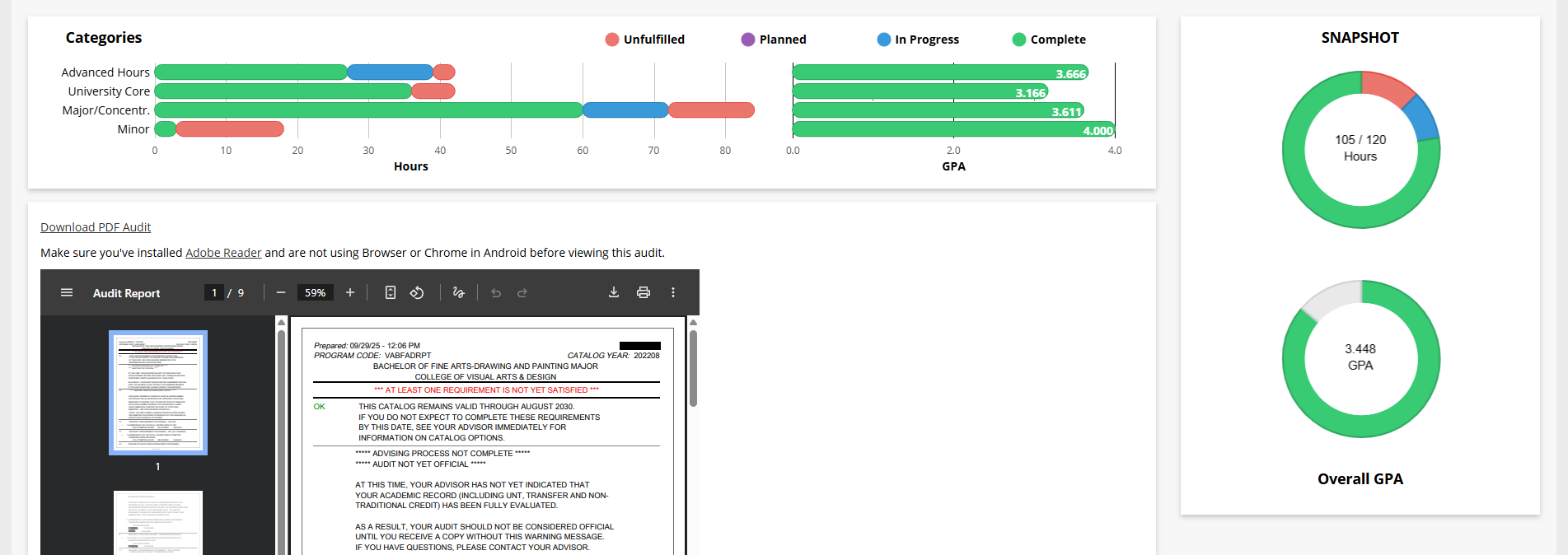
If you run the Audit PDF format by itself, the charts at the top of the ‘Audit Results’ tab will be shown above the audit as usual. You will also be able to switch to the ‘Course History’ and ‘Minors’ tabs. However, instead of having options to open/close sections and a help icon, there will be a link to download the audit and a note about technical requirements to view the Audit PDF format.
Since the Audit PDF format is a static document and not interactive like the Web Audit, which uses HTML, all requirements and sub-requirements are shown automatically. To learn more about requirements and sub-requirements, see the Requirements and sub-requirements section below.
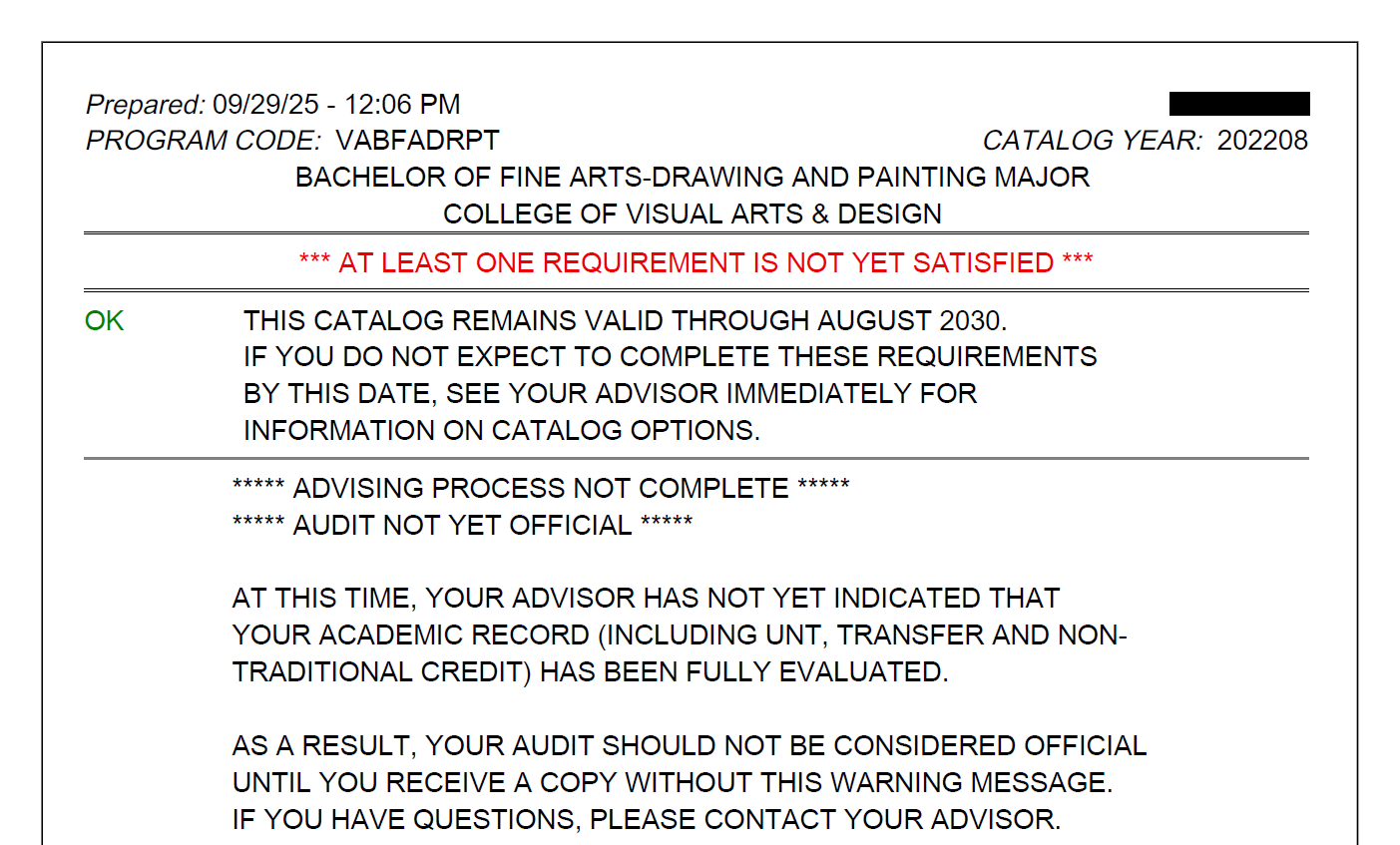
The top of the Audit PDF shows the date and time prepared, your student ID number, your name, the program code (a shorthand name for the college, degree and major), the catalog year and the title of the program.
The requirement and sub-requirement information on the Audit PDF is the exact same as the information on the Web Audit. They are also formatted in a similar way, with the status to the left of the requirements and sub-requirements.
Requirements and Sub-Requirements
On the Web Audit, by default only the title information for each requirement is displayed. You’ll need to expand the requirement section to see more information. Because the Audit PDF is not interactive, all the information for each requirement is already displayed.
Many requirements have additional requirements to be completed, which are called sub-requirements. For example, the Communication university core requirement has two sub-requirements, one sub-requirement for each required group.
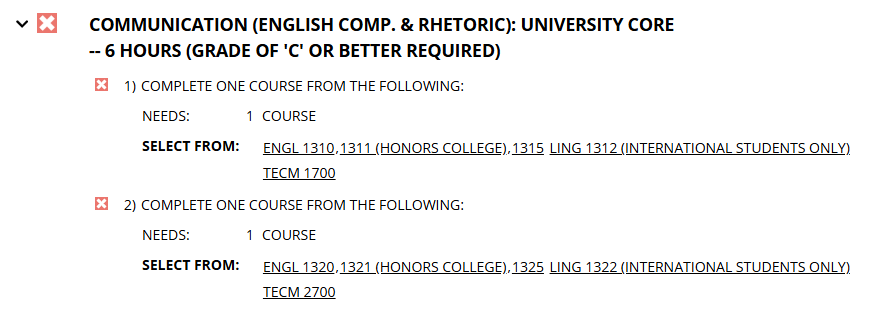
Status
There are different statuses for requirements and sub-requirements:
- Complete: All required courses have been completed.
- In Progress: All required courses have either been completed or are in progress in the current term.
- Unfulfilled: There are still required courses left to complete.
- Note: The “Planned” status is not used at UNT.
The requirement status is noted to the left of each requirement:
| Format | Web Audit | PDF Audit |
|---|---|---|
| Complete Requirement |
|
|
| In Progress Requirement |
|
|
| Unfulfilled Requirement | |
|
The sub-requirement status is noted to the left of each sub-requirement:
| Format | Web Audit | PDF Audit |
|---|---|---|
| Complete Requirement |
|
|
| In Progress Requirement |
|
|
| Unfulfilled Requirement | |
|
Text Requirements
The first few requirements will be text only, providing important information about your audit. These text requirements are explained below.
The text “*** AT LEAST ONE REQUIREMENT IS NOT YET SATISFIED ***” will be displayed below the charts if any requirement is not complete.
![]()
Undergraduate Text Requirements
The first requirement section notifies you when the catalog will expire, based on the catalog year. All requirements of the chosen catalog must be met within eight years of that catalog’s publication for undergraduate programs.

The second requirement section shows whether your advisor has evaluated your degree audit. If the audit has been evaluated, the requirement will say, “ADVISING FLAG SET.” If you are viewing a “what-if” audit, or an audit for a different program, then the advising requirement should always indicate that your audit has not been evaluated and is not official.
Audit has been evaluated:

Audit has not been evaluated:

If you have earned 90 or more credit hours, your audit will show an additional requirement, “SENIORS: GRADUATION/ADVISING NOTICE.” This requirement is informational only. It is intended to help students who may be close to graduation by reminding them to contact their advisor and ensure they are on track to graduate.

Complete Requirements
Expanding a complete requirement will show the earned hours or the number of hours applied to that requirement and a table of the courses that were used to fulfill the requirement. The table will show the following information:
- Year and term the course was taken.
- For information about how course terms are abbreviated on the audit, see the Course information page.
- Subject and course number.
- Number of credit hours of the course.
- Grade earned.
- Title of the course.
Additional information may be displayed below a course, such as if the course was transferred to UNT or the course number changed since the course was taken.

In-Progress Requirements
Requirements will show as In Progress (“IP”) when you are currently registered for a course that is expected to fulfill the requirement.

Note: In some cases, a certain grade may be required for a course to fulfill a requirement. For example, a grade of ‘C’ or higher may be required. When in progress courses are displayed, the audit assumes the required grade will be earned.
Unfulfilled Requirements
Any unfulfilled requirements will indicate what is needed to complete the requirement, such as a certain number of courses. Unfulfilled requirements will also provide a list of courses that can be used to fulfill that requirement. You can click on a course number in the “SELECT FROM” list to see a description of that course.

Partially fulfilled requirements will show both what has been used to fulfill part of the requirement and what else is needed. If even one part of the requirement is incomplete, the requirement status will be unfulfilled. In the example below, the “LIFE & PHYSICAL SCIENCES: UNIVERSITY CORE” requirement is unfulfilled. One course worth 3 hours is complete. However, the requirement is unfulfilled because 6 hours are required and only 3 hours have been added.
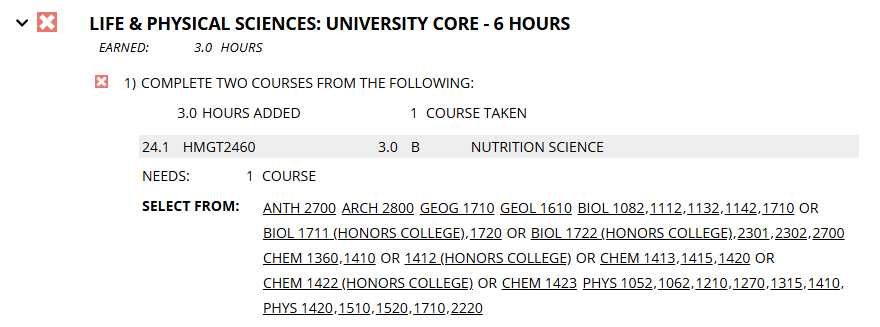
ORed Requirements and Sub-Requirements
In some cases, you may only need to complete one requirement or sub-requirement from a list. These requirements and sub-requirements are ORed—they will say “OR” next to them. The degree audit doesn’t know which requirement or sub-requirement you will complete, so each ORed option will be shown and each course will be applied to one area, even if the course is an option for multiple areas. Once one of the ORed options is able to be completed, the audit will automatically consolidate the courses into that one option.
Example of ORed requirements
In this example, the different track options for the B.A. in Commercial Music are ORed requirements. You only need to complete one track, not all four of them. Once one track is complete, the other tracks will no longer show as unfulfilled.
ORed requirements for the B.A. in Commercial Music tracks, with all requirements unfulfilled:

ORed requirements for the B.A. in Commercial Music tracks, with one requirement complete:

Example of ORed sub-requirements
In this example, the different calculus sequence options for the B.S. in Physics are ORed sub-requirements. Since the audit doesn’t know which sequence you intend to complete, it temporarily places MATH 1710 in the last applicable sub-requirement.
ORed sub-requirements for the calculus sequence, with no courses taken:

ORed sub-requirements for the calculus sequence, with MATH 1710 taken:
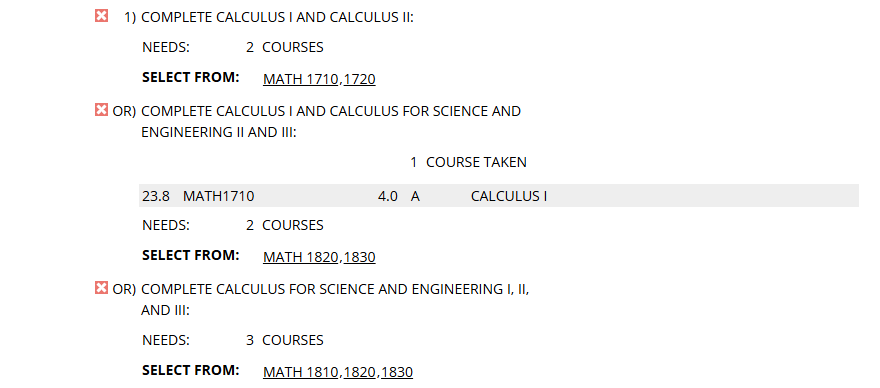
ORed sub-requirements for the calculus sequence, with one option fully complete:

Other Requirements
Some requirements don’t require specific courses at all. Instead, a certain GPA or a certain number of courses taken at UNT may be required. Other requirements may just be text to provide important information about the program and your audit, like the text requirements at the beginning of your audit. Remember, you can expand a requirement section for additional details.
In the example below, the “UNIVERSITY REQTS FOR DEGREE -- ADVANCED HOURS (UNT)” requirement doesn’t need any specific courses. Instead, it requires a certain number of advanced credit hours earned in residence at UNT. The requirement is "In Progress" because the student is currently taking courses that will help fulfill this requirement.

Note: Courses earned in residence at UNT are courses that you took at UNT.
Have more questions about your degree audit? Your advisor will be able to explain your audit and help you decide on the best course of action to help you achieve your goals. You can find a list of advising offices on the Get Advised page.
A printable (PDF) version of this documentation is also available: Your Online Degree Audit.